Foliar Application of Different Iron Sources Improves Morpho-Physiological Traits and Nutritional Quality of Broad Bean Grown in Sandy Soil
Abstract
1. Introduction
2. Results
2.1. Vegetative Growth
2.2. Photosynthetic Pigments and Gas Exchange Parameters
2.3. Leaf Phytohormones Concentration
2.4. Seed Nutrient Content
2.5. Seed Carbohydrate, Crude Protein, Fat and Moisture Content
2.6. Amino Acid Compounds Profile of Broad Bean Seeds
2.7. Yield and its components
2.8. Anatomy of the Leaflet
2.9. Correlation Study
3. Discussion
4. Materials and Methods
4.1. Synthesis and Characterization of Iron Nanoparticle
4.2. Growth and Yield Parameters
4.2.1. Physiological Traits
Photosynthetic Pigments
- -
- Chlorophyll a = 12.70 × A663 − 2.79 × A647
- -
- Chlorophyll b = 20 × A647 − 4.62 × A663
- -
- Carotenoids = {1000 × A470 − (3.27 chl. A − 104 chl. B)}/229
Gas Exchange Parameters
Seed Nutrient Content
Gibberellic Acid, Indole-3-Acetic Acid and Abscisic Acid
Seed Protein Content
Seed Carbohydrate and Fat Content
Seed Amino Acids Content
4.2.2. Leaf Anatomy
4.3. Statistical Analysis
5. Conclusions
Supplementary Materials
Author Contributions
Funding
Data Availability Statement
Acknowledgments
Conflicts of Interest
References
- Crépon, K.; Marget, P.; Peyronnet, C.; Carrouee, B.; Arese, P.; Duc, G. Nutritional value of faba bean (Vicia faba L.) seeds for feed and food. Field Crops Res. 2010, 115, 329–339. [Google Scholar] [CrossRef]
- Nasrallah, A.K.; Kheder, A.A.; Kord, M.A.; Fouad, A.S.; El-Mogy, M.M.; Atia, M.A. Mitigation of Salinity Stress Effects on Broad Bean Productivity Using Calcium Phosphate Nanoparticles Application. Horticulturae 2022, 8, 75. [Google Scholar] [CrossRef]
- Abdelaziz, M.E.; Atia, M.A.M.; Abdelsattar, M.; Abdelaziz, S.M.; Ibrahim, T.A.A.; Abdeldaym, E.A. Unravelling the Role of Piriformospora indica in CombatingWater Deficiency by Modulating Physiological Performance and Chlorophyll Metabolism-Related Genes in Cucumis sativus. Horticulturae 2021, 7, 399. [Google Scholar] [CrossRef]
- Mahmoud, A.W.M.; Samy, M.M.; Sany, H.; Eid, R.R.; Rashad, H.M.; Abdeldaym, E.A. Nanopotassium, Nanosilicon, and Biochar Applications Improve Potato Salt Tolerance by Modulating Photosynthesis, Water Status, and Biochemical Constituents. Sustainability 2022, 14, 723. [Google Scholar] [CrossRef]
- Abdeldym, E.A.; El-Mogy, M.M.; Abdellateaf, H.R.L.; Atia, M.A.M. Genetic Characterization, Agro-Morphological and Physiological Evaluation of Grafted Tomato under Salinity Stress Conditions. Agronomy 2020, 10, 1948. [Google Scholar] [CrossRef]
- Shehata, S.A.; Omar, H.S.; Elfaidy, A.G.; EL-Sayed, S.S.; Abuarab, M.E.; Abdeldaym, E.A. Grafting enhances drought stress tolerance by regulating stress-responsive gene expression and antioxidant enzyme activities in cucumbers. BMC Plant Biol. 2022, 22, 408. [Google Scholar] [CrossRef]
- Abuarab, M.E.; Hafez, S.M.; Shahein, M.M.; Hassan, A.M.; El-Sawy, M.B.; El-Mogy, M.M.; Abdeldaym, E.A. Irrigation scheduling for green beans grown in clay loam soil under a drip irrigation system. Water SA 2020, 46, 573–582. [Google Scholar]
- EL-Bauome, H.A.; Abdeldaym, E.A.; Abd El-Hady, M.A.M.; Darwish, D.B.E.; Alsubeie, M.S.; El-Mogy, M.M.; Basahi, M.A.; Al-Qahtani, S.M.; Al-Harbi, N.A.; Alzuaibr, F.M.; et al. Exogenous Proline, Methionine, and Melatonin Stimulate Growth, Quality, and Drought Tolerance in Cauliflower Plants. Agriculture 2022, 12, 1301. [Google Scholar] [CrossRef]
- Thakur, P.; Nayyar, H. Facing the cold stress by plants in the changing environment: Sensing, signaling, and defending mechanisms. In Plant Acclimation to Environmental Stress; Springer: New York, NY, USA, 2013; pp. 29–69. [Google Scholar]
- Fahad, S.; Bajwa, A.A.; Nazir, U.; Anjum, S.A.; Farooq, A.; Zohaib, A.; Sadia, S.; Nasim, W.; Adkins, S.; Saud, S.; et al. Crop production under drought and heat stress: Plant responses and management options. Front. Plant Sci. 2017, 8, 1147. [Google Scholar] [CrossRef] [PubMed]
- Berger, S.; Ellersiek, U.; Westhoff, P.; Steinmüller, K. Studies on the expression of NDH-H, a subunit of the NAD (P) H-plastoquinone-oxidoreductase of higher-plant chloroplasts. Planta 1993, 190, 25–31. [Google Scholar] [CrossRef]
- Zuo, Y.; Zhang, F. Soil and crop management strategies to prevent iron deficiency in crops. Plant Soil. 2011, 339, 83–95. [Google Scholar] [CrossRef]
- Mimmo, T.; Del Buono, D.; Terzano, R.; Tomasi, N.; Vigani, G.; Crecchio, C.; Cesco, S. Rhizospheric organic compounds in the soil–microorganism–plant system: Their role in iron availability. Eur. J. Soil Sci. 2014, 65, 629–642. [Google Scholar] [CrossRef]
- Bindraban, P.S.; Dimkpa, C.; Nagarajan, L.; Roy, A.; Rabbinge, R. Revisiting fertilisers and fertilization strategies for improved nutrient uptake by plants. Biol. Fertil. Soils 2015, 51, 897–911. [Google Scholar] [CrossRef]
- Ye, L.; Li, L.; Wang, L.; Wang, S.; Li, S.; Du, J.; Shou, H. MPK3/MPK6 are involved in iron deficiency-induced ethylene production in Arabidopsis. Front. Plant Sci. 2015, 6, 953. [Google Scholar] [CrossRef] [PubMed]
- Kobayashi, T.; Nishizawa, N.K. Iron uptake, translocation, and regulation in higher plants. Annu. Rev. Plant Biol. 2012, 63, 131–152. [Google Scholar] [CrossRef]
- Zargar, S.M.; Agrawal, G.K.; Rakwal, R.; Fukao, Y. Quantitative proteomics reveals role of sugar in decreasing photosynthetic activity due to Fe deficiency. Front. Plant Sci. 2015, 6, 592. [Google Scholar] [CrossRef] [PubMed]
- Gülser, F.; Yavuz, H.İ.; Gökkaya, T.H.; Sedef, M. Effects of iron sources and doses on plant growth criteria in soybean seedlings. Eurasian J. Soil Sci. 2019, 8, 298–303. [Google Scholar] [CrossRef][Green Version]
- Connorton, J.M.; Jones, E.R.; Rodríguez-Ramiro, I.; Fairweather-Tait, S.; Uauy, C.; Balk, J. Wheat Vacuolar Iron Transporter TaVIT2 Transports Fe and Mn and Is Effective for Biofortification. Plant Physiol. 2017, 174, 2434. [Google Scholar] [CrossRef]
- Sastry, R.K.; Rao, N.H.; Cahoon, R.; Tucker, T. Can nanotechnology provide the innovations for a second green revolution in Indian agriculture? In Proceedings of the NSF Nanoscale Science and Engineering Grantees Conference, Arlington, VA, USA, 3–6 December 2007; pp. 3–6. [Google Scholar]
- Sanguansri, P.; Augustin, M.A. Nanoscale materials development–a food industry perspective. Trends Food Sci. Technol. 2006, 17, 547–556. [Google Scholar] [CrossRef]
- Chen, H.; Yada, R. Nanotechnologies in agriculture: New tools for sustainable development. Trends Food Sci. Technol. 2011, 22, 585–594. [Google Scholar] [CrossRef]
- Gui, X.; He, X.; Ma, Y.; Zhang, P.; Li, Y.; Ding, Y.; Zhao, Y. Quantifying the distribution of ceria nanoparticles in cucumber roots: The influence of labeling. RSC Adv. 2015, 5, 4554–4560. [Google Scholar] [CrossRef]
- Hema, E.; Manikandan, A.; Karthika, P.; Durka, M.; Antony, S.A.; Venkatraman, B.R. Magneto-optical properties of reusable spinel NixMg1−xFe2O4 (0.0 ≤ x ≤ 1.0) nano-catalysts. J. Nanosci. Nanotechnol. 2016, 16, 7325–7336. [Google Scholar] [CrossRef]
- Ravichandran, A.T.; Srinivas, J.; Karthick, R.; Manikandan, A.; Baykal, A. Facile combustion synthesis, structural, morphological, optical and antibacterial studies of Bi1−xAlxFeO3 (0.0 ≤ x ≤ 0.15) nanoparticles. Ceram. Int. 2018, 44, 13247–13252. [Google Scholar] [CrossRef]
- Subramanian, A.P.; Jaganathan, S.K.; Manikandan, A.; Pandiaraj, K.N.; Gomathi, N.; Supriyanto, E. Recent trends in nano-based drug delivery systems for efficient delivery of phytochemicals in chemotherapy. RSC Adv. 2016, 6, 48294–48314. [Google Scholar] [CrossRef]
- Sidorowicz, A.; Maqbool, Q.; Nazar, M. Future of nanofertilizer. In Nanotechnology for Agriculture: Crop Production & Protection; Springer: Singapore, 2019; pp. 143–152. [Google Scholar]
- Elmer, W.; White, J.C. The future of nanotechnology in plant pathology. Annu. Rev. Phytopathol. 2018, 56, 111–133. [Google Scholar] [CrossRef] [PubMed]
- Prasad, R.; Shivay, Y.S.; Kumar, D. Agronomic biofortification of cereal grains with iron and zinc. Adv. Agron. 2014, 125, 55–91. [Google Scholar]
- Schmidt, J.H.; Hallmann, J.; Finckh, M.R. Bacterivorous nematodes correlate with soil fertility and improved crop production in an organic minimum tillage system. Sustainability 2020, 12, 6730. [Google Scholar] [CrossRef]
- Shang, Y.; Hasan, M.K.; Ahammed, G.J.; Li, M.; Yin, H.; Zhou, J. Applications of Nanotechnology in Plant Growth and CropProtection: A Review. Molecules 2019, 24, 2558. [Google Scholar] [CrossRef] [PubMed]
- Ghormade, V.; Deshpande, M.V.; Paknikar, K.M. Perspectives for nano-biotechnology enabled protection and nutrition of plants. Biotechnol. Adv. 2011, 29, 792–803. [Google Scholar] [CrossRef]
- Elfeky, S.A.; Mohammed, M.A.; Khater, M.S.; Osman, Y.A.; Elsherbini, E. Effect of magnetite nano-fertilizer on growth and yield of Ocimum basilicum L. Int. J. Indig. Med. Plants 2013, 46, 1286–11293. [Google Scholar]
- Wang, H.; Kou, X.; Pei, Z.; Xiao, J.Q.; Shan, X.; Xing, B. Physiological effects of magnetite (Fe3O4) nanoparticles on perennial ryegrass (Lolium perenne L.) and pumpkin (Cucurbita mixta) plants. Nanotoxicology 2011, 5, 30–42. [Google Scholar] [CrossRef] [PubMed]
- Plaksenkova, I.; Jermaļonoka, M.; Bankovska, L.; Gavarāne, I.; Gerbreders, V.; Sledevskis, E.; Sniķeris, J.; Kokina, I. Effects of Fe3O4 nanoparticle stress on the growth and development of rocket Eruca sativa. J. Nanomater. 2019, 2019, 1–10. [Google Scholar] [CrossRef]
- El-Gioushy, S.F.; Ding, Z.; Bahloul, A.M.; Gawish, M.S.; Abou El Ghit, H.M.; Abdelaziz, A.M.; El-Desouky, H.S.; Sami, R.; Khojah, E.; Hashim, T.A.; et al. Foliar Application of Nano, Chelated, and Conventional Iron Forms Enhanced Growth, Nutritional Status, Fruiting Aspects, and Fruit Quality of Washington Navel Orange Trees (Citrus sinensis L. Osbeck). Plants 2021, 10, 2577. [Google Scholar] [CrossRef] [PubMed]
- Ruiz-Espinoza, F.H.; Murillo-Amador, B.; Garcia-Hernandez, J.L.; Fenech-Larios, L.; Rueda-Puente, E.O.; Troyo-Dieguez, E.; Kaya, C.; Beltran-Morales, A. Field evaluation of the relationship between chlorophyll content in basil leaves and a portable chlorophyll meter (SPAD-502) readings. J. Plant Nutr. 2010, 33, 423–438. [Google Scholar] [CrossRef]
- Feng, Y.J.; Shi, B.S.; Dong, G.M.; Zhang, Q. The application of chlorophyll fluorescence kinetics in plant stress and fruit storage. J. Hebei Agric. Uni. 2003, 26, 89–92. [Google Scholar] [CrossRef]
- El-Mogy, M.M.; Salama, A.M.; Mohamed, H.F.Y.; Abdelgawad, K.F.; Abdeldaym, E.A. Responding of long green pepper plants to different sources of foliar potassium fertiliser. Agric. Pol’nohospod. 2019, 65, 59–76. [Google Scholar] [CrossRef]
- Pérez-Gálvez, A.; Viera, I.; Roca, M. Carotenoids and chlorophylls as antioxidants. Antioxidants 2020, 9, 505. [Google Scholar] [CrossRef] [PubMed]
- Timperio, A.M.; D’Amici, G.M.; Barta, C.; Loreto, F.; Zolla, L. Proteomics, pigment composition, and organization of thylakoid membranes in iron-deficient spinach leaves. J. Exp. Bot. 2007, 58, 3695–3710. [Google Scholar] [CrossRef] [PubMed]
- Li, J.L.; Hu, J.; Xiao, L.; Wang, Y.Q.; Wang, X.L. Interaction mechanisms between a-Fe2O3, Fe2O3 and Fe3O4 nanoparticles and Citrus maxima seedlings. Sci. Total Environ. 2018, 625, 677–685. [Google Scholar] [CrossRef]
- Mahmoud, A.W.M.; Abdelaziz, S.M.; El-mogy, M.M.; Abdeldaym, E.A. Effect of Foliar Zno and Feo Nanoparticles Application on Growth and Nutritional Quality of Red Radish and Assessment of Their Accumulation on Human Health. Agriculture 2019, 65, 16–29. [Google Scholar] [CrossRef]
- Maswada, H.F.; Djanaguiraman, M.; Prasad, P.V.V. Seed treatment with nano-iron (III) oxide enhances germination, seeding growth and salinity tolerance of sorghum. J. Agron. Crop Sci. 2018, 204, 577–587. [Google Scholar] [CrossRef]
- Osmond, C.B.; Bj€orkman, O.; Anderson, D.J. Physiological Processes in Plant Ecology; Springer Science & Business Media: Berlin/Heidelberg, Germany, 2012; Available online: https://www.springer.com/gp/book/9783642676390 (accessed on 27 September 2022).
- Liu, H.; Yang, L.; Li, N.; Zhou, C.; Feng, H.; Yang, J.; Han, X. Cadmium toxicity reduction in rice (Oryza sativa L.) through iron addition during primary reaction of photosynthesis. Ecotoxicol. Environ. Saf. 2020, 200, 110746. [Google Scholar] [CrossRef]
- Li, J.; Zhen, W.; Long, D.; Ding, L.; Gong, A.; Xiao, C.; Jiang, W.; Liu, X.; Zhou, T.; Huang, L. De novo sequencing and assembly analysis of the Pseudostellaria heterophylla transcriptome. PLoS ONE 2016, 11, e0164235. [Google Scholar] [CrossRef] [PubMed]
- Kazemi, M. Effect of foliar application of iron and zinc on growth and productivity of cucumber. Bull. Envrion. Pharmacol. Life Sci. 2013, 2, 11–14. [Google Scholar]
- Fernández, V.; Del Río, V.; Pumariño, L.; Igartua, E.; Abadía, J.; Abadía, A. Foliar fertilization of peach (Prunus persica (L.) Batsch) with different iron formulations: Effects on re-greening, iron concentration and mineral composition in treated and untreated leaf surfaces. Sci. Hort. 2008, 117, 241–248. [Google Scholar] [CrossRef]
- Davière, J.M.; Achard, P. Apivotal role of DELLA sin regulating multiple hormonesignals. Mol. Plant 2016, 9, 10–20. [Google Scholar] [CrossRef]
- Lucini, N.; Bernardo, L. Comparison of proteome response to saline and zinc stress in lettuce. Front. Plant Sci. 2015, 6, 240. [Google Scholar] [CrossRef]
- Vattani, H.; Keshavarz, N.; Baghaei, N. Effect of sprayed soluble different levels of iron chelate Nano fertilizer on nutrient uptake efficiency in two varieties of spinach. Intl. Res. J. Appl. Basic Sci. 2012, 3, 2651–2656. [Google Scholar]
- Rasht, I. Effect of application of iron fertilizers in two methods’ foliar and soil application’on growth characteristics of Spathyphyllum illusion. Eur. J. Exp. Biol. 2013, 3, 232–240. [Google Scholar]
- Adel, M.A.H.A.M.; Ahmed, O.I. The effect of spraying with nan iron and gibberellic acid on the chemical traits of Moringa oleifera seedlings growing in two agricultural medium. Euphrates J. Agric. Sci. 2020, 12, 456–472. [Google Scholar]
- Vwioko, E.D.; El-Esawi, M.A.; Imoni, M.E.; Al-Ghamdi, A.A.; Ali, H.M.; El-Sheekh, M.M.; Abdeldaym, E.A.; Al-Dosary, M.A. Sodium Azide Priming Enhances Waterlogging Stress Tolerance in Okra (Abelmoschus esculentus L.). Agronomy 2019, 9, 679. [Google Scholar] [CrossRef]
- Konate, A.; Wang, Y.Y.; He, X.; Adeel, M.; Zhang, P.; Ma, Y.H.; Ding, Y.Y.; Zhang, J.Z.; Yang, J.; Kiztio, S.; et al. Comparative effects of nano and bulk-Fe3O4 on the growth of cucumber (Cucumis sativus). Ecotoxicol. Environ. Saf. 2018, 165, 547–554. [Google Scholar] [CrossRef] [PubMed]
- Mahmoud, A.M.; Esmail, S.E.A.; El-Attar, A.B.; Othman, E.Z.; El-Bahbohy, R.M. Prospective Practice for Compound Stress Tolerance in Thyme Plants Using Nanoparticles and Biochar for Photosynthesis and Biochemical Ingredient Stability. Agronomy 2022, 12, 1069. [Google Scholar] [CrossRef]
- Waters, B.M.; Amundsen, K.; Graef, G. Gene Expression Profiling of Iron Deficiency Chlorosis Sensitive and Tolerant Soybean Indicates Key Roles for Phenylpropanoids under Alkalinity Stress. Front. Plant Sci. 2018, 9, 10. [Google Scholar] [CrossRef] [PubMed]
- Barłóg, P.; Grzebisz, W.; Łukowiak, R. The effect of potassium and sulfur fertilization on seed quality of faba bean (Vicia faba L.). Agronomy 2019, 9, 209. [Google Scholar] [CrossRef]
- Müller, C.; Kuki, K.N.; Pinheiro, D.T.; de Souza, L.R.; Siqueira Silva, A.I.; Loureiro, M.E.; Oliva, M.A.; Almeida, A.M. Differential physiological responses in rice upon exposure to excess distinct iron forms. Plant Soil. 2015, 391, 123–138. [Google Scholar] [CrossRef]
- Nadi, E.; Aynehband, A.; Mojaddam, M. Effect of nano-iron chelate fertilizer on grain yield, protein percent and chlorophyll content of Faba bean (Vicia faba L.). Int. J. Biosci. 2013, 3, 267–272. [Google Scholar]
- Hong, J.; Xu, D.; Yu, J.; Gong, P.; Ma, H.; Yao, S. Facile synthesis of polymer-enveloped ultrasmall superparamagnetic iron oxide for magnetic resonance imaging. Nanotechnology 2007, 18, 135608. [Google Scholar] [CrossRef]
- Abdalla, A.A.; El Naim, A.M.; Ahmed, M.F.; Taha, M.B. Biological yield and harvest index of faba bean (Vicia faba L.) as affected by different agro-ecological environments. World J. Agric. Res. 2015, 3, 78–82. [Google Scholar]
- Merwad, A.-R.M.; Desoky, E.-S.M.; Rady, M.M. Response of water deficit-stressed Vigna unguiculata performances to silicon, proline or methionine foliar application. Sci. Hortic. 2018, 228, 132–144. [Google Scholar] [CrossRef]
- Abdallah, I.S.; Atia, M.A.; Nasrallah, A.K.; El-Beltagi, H.S.; Kabil, F.F.; El-Mogy, M.M.; Abdeldaym, E.A. Effect of new pre-emergence herbicides on quality and yield of potato and its associated weeds. Sustainability 2021, 13, 9796. [Google Scholar] [CrossRef]
- Liu, F.; Andersen, M.N.; Jacobsen, S.E.; Jensen, C.R. Stomatal control and water use efficiency of soybean (Glycine max L. Merr.) during progressive soil drying. Environ. Exp. Bot. 2005, 54, 33–34. [Google Scholar] [CrossRef]
- Mahmoud, A.W.M.; Swaefy, H.M. Comparison between Commercial and Nano NPK in Presence of Nano Zeolite on Sage Plant Yield and its Components under Water Stress. Agriculture 2020, 66, 24–39. [Google Scholar] [CrossRef]
- AOAC. Official Methods of Analysis, 11th ed.; Association of Official Analytical Chemists: Washington, DC, USA, 1970. [Google Scholar]
- Watanabe, F.S.; Olsen, S.R. Test of an ascorbic acid method for determining water and NaHCO3 extracts from soil. Soil Sci. Soc. Am. Proc. 1965, 29, 677. [Google Scholar] [CrossRef]
- Mahmoud, A.W.M.; El-Attar, A.B.; Esmail, S.E.A.; Sany, H. Boosting biochemical composition of stevia plant using biochar loaded with beneficial microorganism strains. Bulg. J. Agric. Sci. 2020, 26, 748–760. [Google Scholar]
- AOAC. Official Methods of Analysis. In Method 937-07 Fish and Marine Products–Treatment and Sample Preparation Procedure; AOAC: Rockville, MD, USA, 2000. [Google Scholar]
- Abdeldaym, E.A.; Traversa, A.; Cocozza, C.; Brunetti, G. Effects of a 2-Year application of different residual biomasses on soil properties and potato yield. Clean Soil Air Water 2018, 46, 1800261. [Google Scholar] [CrossRef]
- Pellett, P.L.; Young, V.R. Nutritional Evaluation of Protein Foods; Pub No. WHTR-3/UNUP-129; The United Nations University: Tokyo, Japan, 1980. [Google Scholar]
- Johansen, D.A. Plant Microtechnique; McGraw-Hill Book Company, Inc.: London, UK, 1940; 530p. [Google Scholar]
- Shapiro, S.S.; Wilk, M.B. Analysis of variance test for normality (complete samples). Biometrika 1965, 52, 591–611. [Google Scholar] [CrossRef]
- Hartley, H. The maximum F-ratio as a short cut test for homogeneity of variance. Biometrika 1950, 37, 308–312. [Google Scholar] [PubMed]
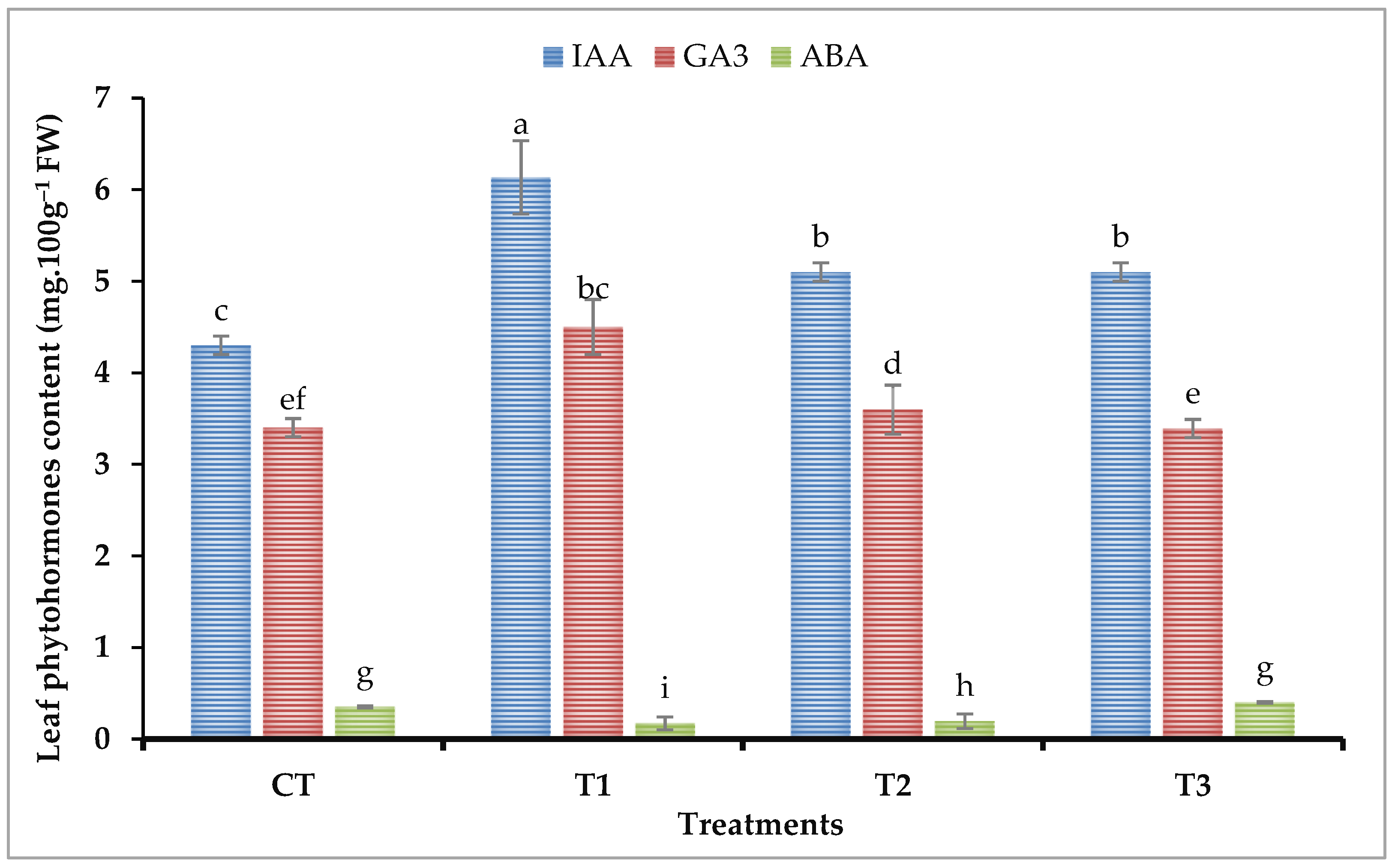
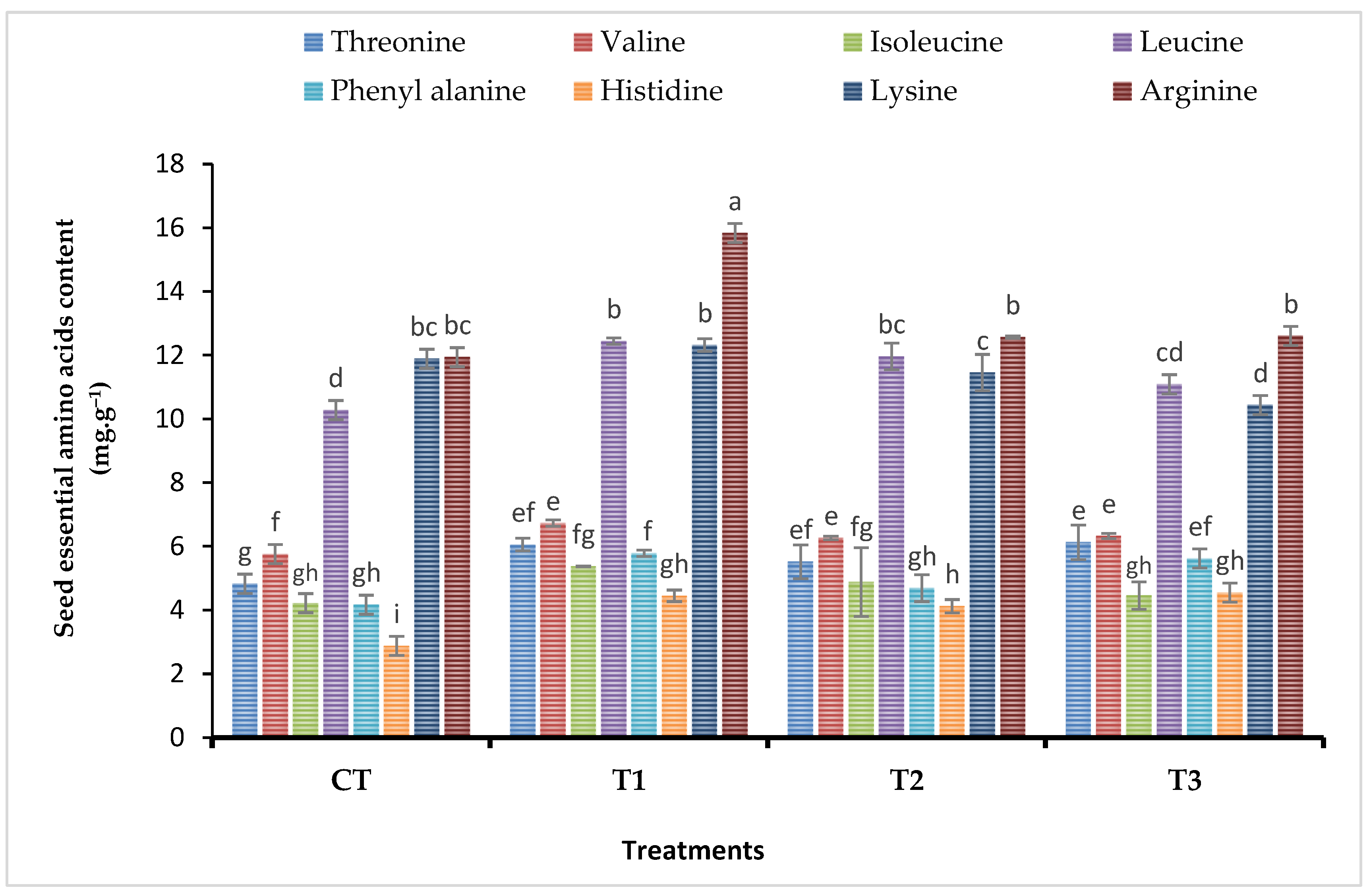
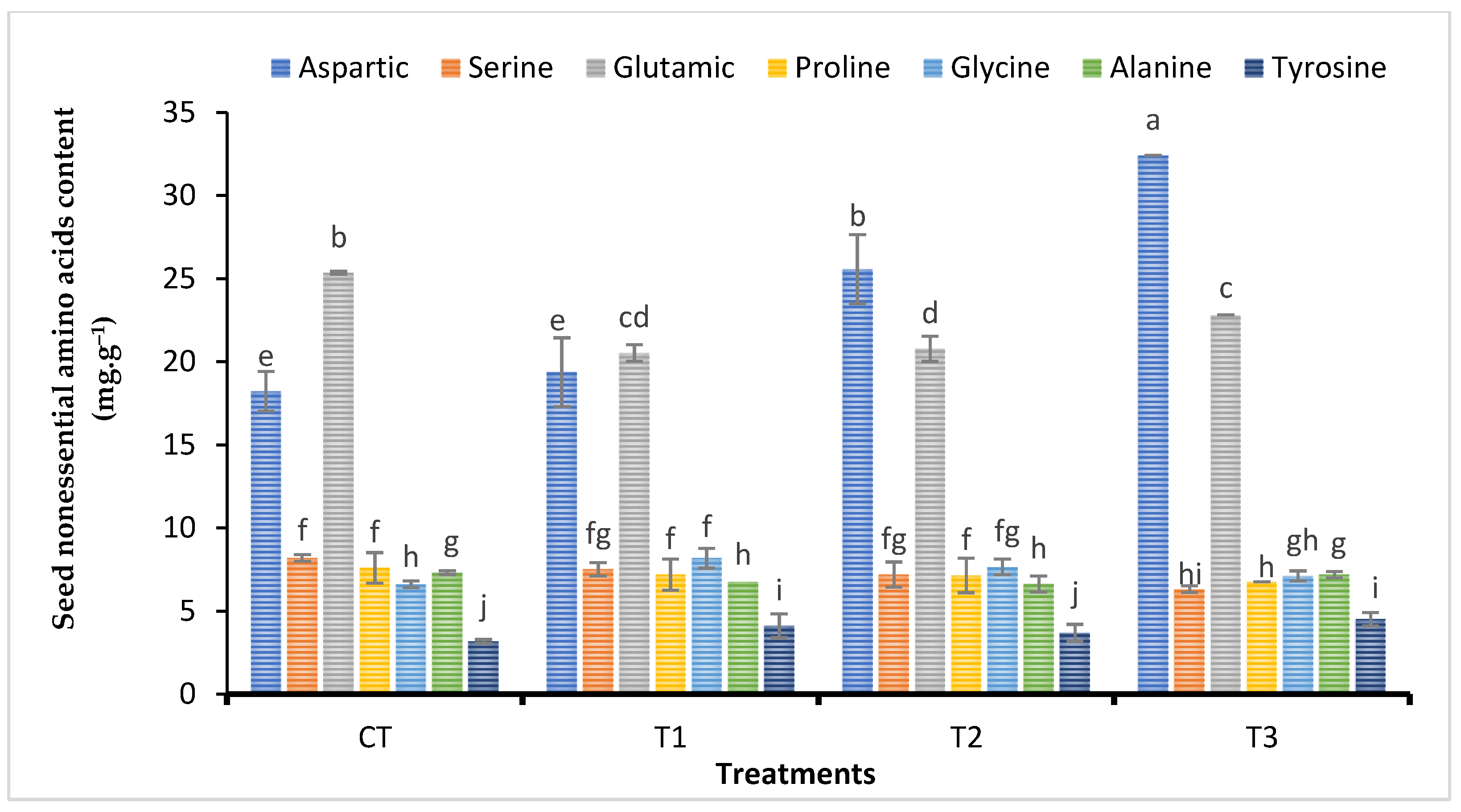
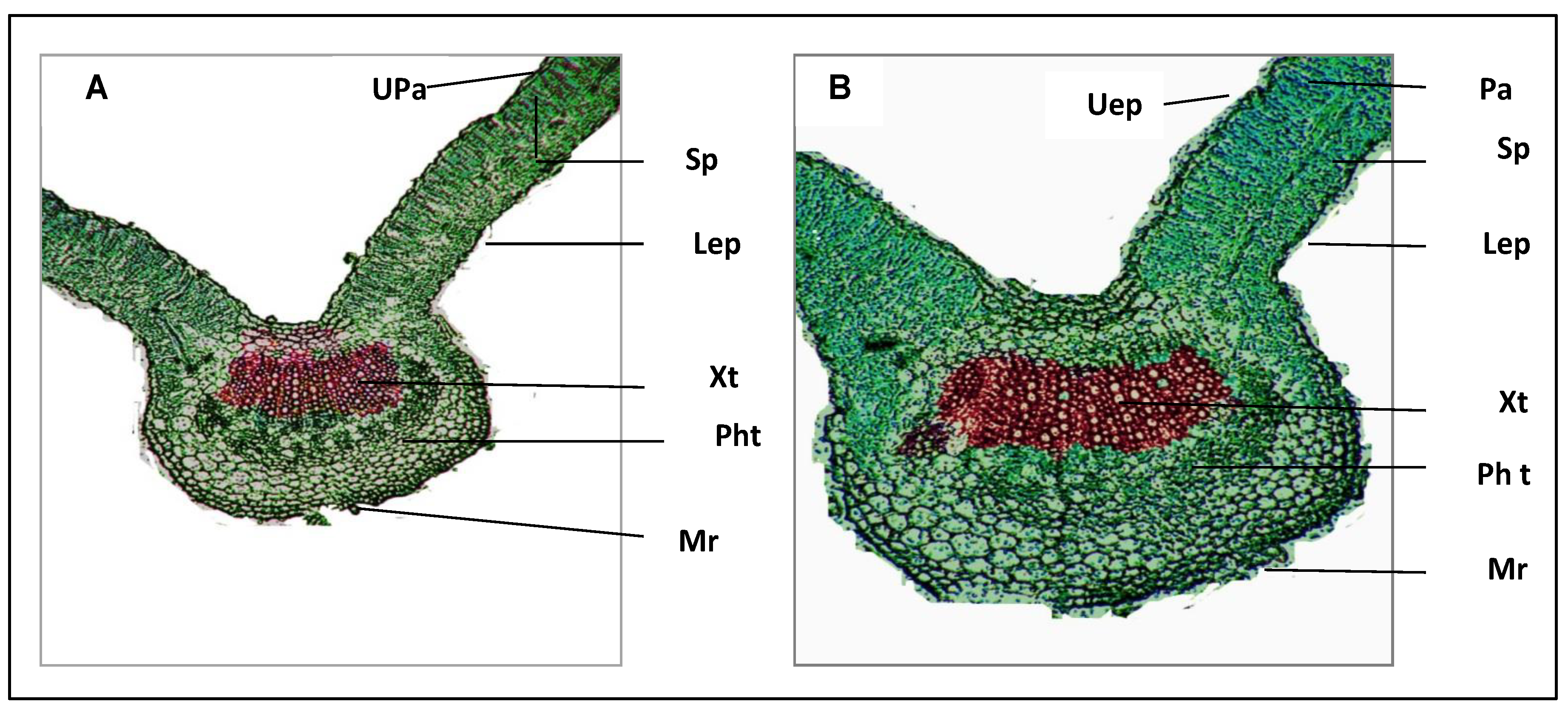
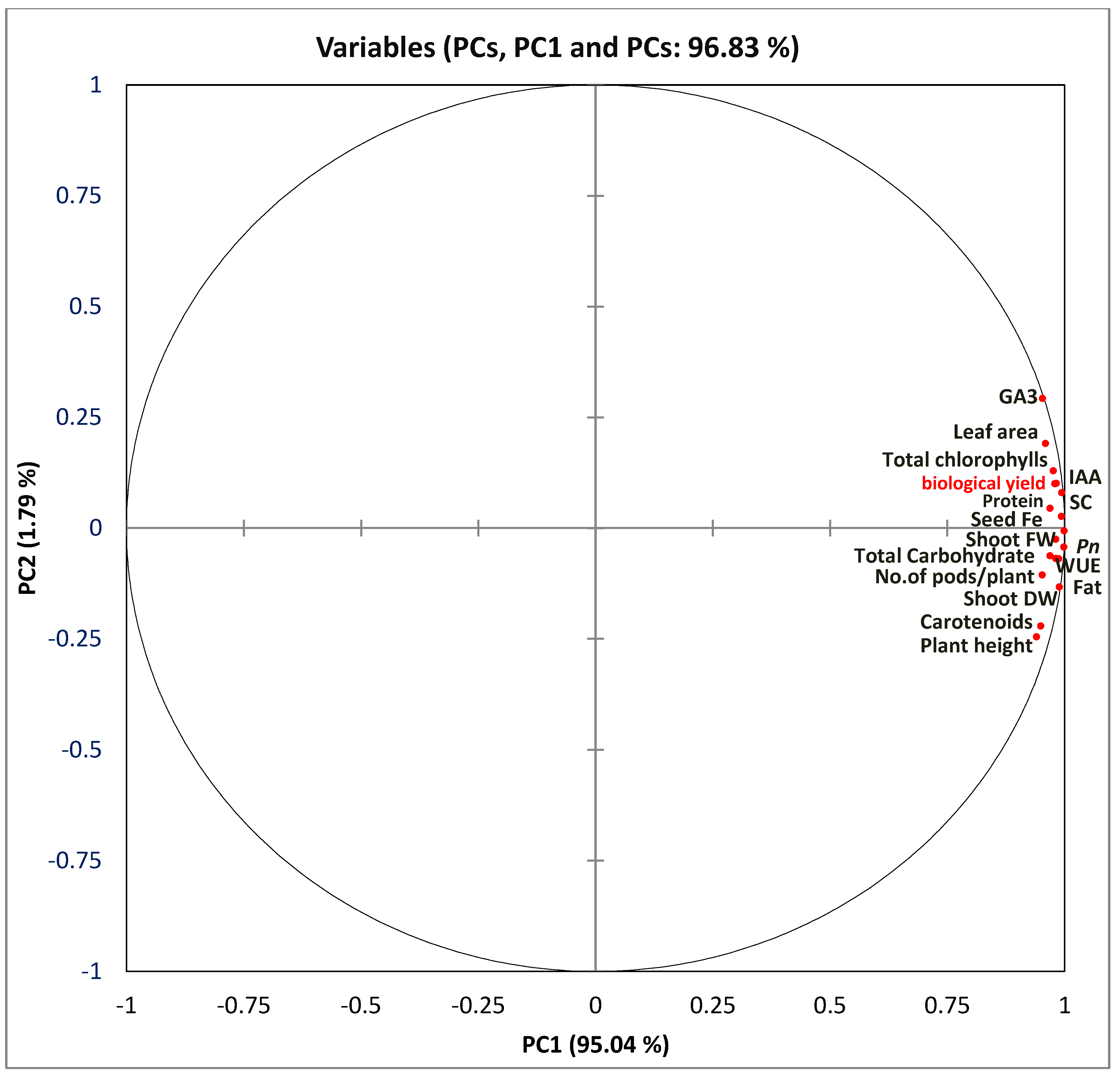
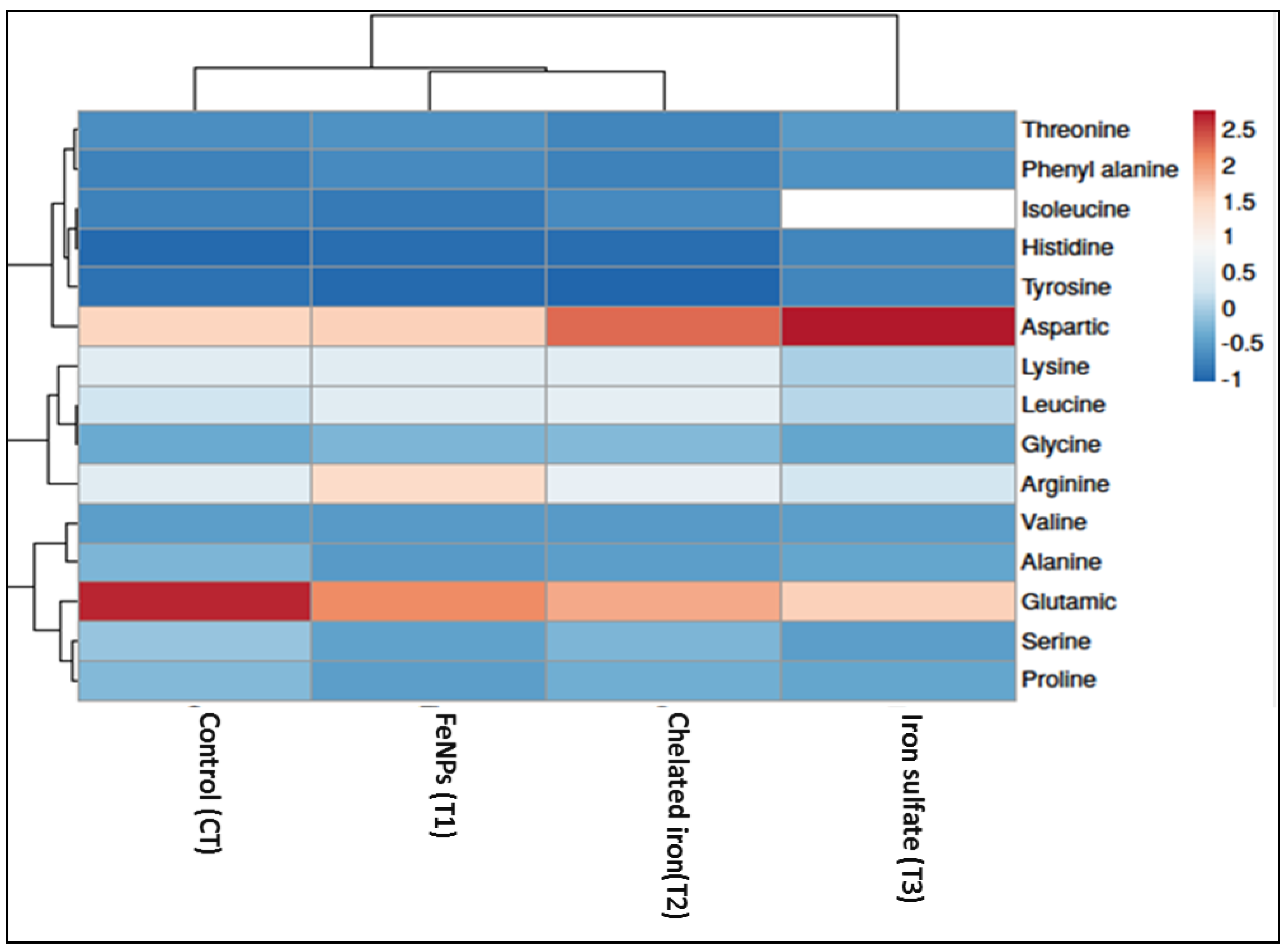

| Treatments | Plant Height (cm) | Leaf Area (cm2) | No. of Branches /Plant | Shoot FW (g/plant) | Shoot DW (g/plant) |
|---|---|---|---|---|---|
| CT | 78.4 ± 3.22 d | 12.52 ± 1.25 c | 3.2 ± 0.21 d | 150.62 ± 5.23 d | 37.11 ± 1.23 cd |
| T1 | 120.6 ± 6.55 a | 20.46 ± 3.01 a | 6.8 ± 0.51 a | 191.40 ± 4.1 a | 45.3 ± 3.2 a |
| T2 | 106.3 ± 4.21 b | 15.33 ± 1.45 b | 5.1 ± 0.42 b | 175.33 ± 3.1 b | 41.8 ± 0.98 b |
| T3 | 98.5 ± 2.55 c | 13.62 ± 2.34 c | 4.3 ± 0.15 c | 156.61 ± 3.7 c | 39.13 ± 0.25 c |
| Treatments | Total Chlorophyll (mg.100 g−1 F.W) | Carotenoids (mg.100 g−1 F.W) | Pn (µmol m–2s−1) | SC (mmol m–2s−1) | WUE (μmol. mmol−1) |
|---|---|---|---|---|---|
| CT | 86.49 ± 4.66 c | 22.19 ± 1.22 b | 8.41 ± 0.7 c | 0.21 ± 0.005 c | 9.11 ± 0.98 c |
| T1 | 101.12 ± 5.01 a | 27.11 ± 2.02 a | 20.01 ± 0.8 a | 0.35 ± 0.007 a | 18.06 ± 1.08 a |
| T2 | 90.45 ± 4.23 b | 24.79 ± 1.87 b | 14.15 ± 0.4 b | 0.29 ± 0.003 b | 12.09 ± 2.01 b |
| T3 | 89.71 ± 3.99 c | 23.61 ± 3.11 b | 10.16 ± 0.2 c | 0.25 ± 0.009 b | 10.67 ± 0.790 c |
| Treatments | N (%) | P (%) | K (%) | Ca (%) | Fe (ppm) | Zn (ppm) | Mn (ppm) |
|---|---|---|---|---|---|---|---|
| CT | 1.91 ± 0.11 c | 0.09 ± 0.03 d | 1.30 ± 0.33 d | 0.11 ± 0.001 b | 51.8 ± 5.11 d | 32.6 ± 2.32 d | 24.6 ± 1.54 b |
| T1 | 3.85 ± 0.89 a | 0.39 ± 0.009 a | 1.76 ± 0.15 a | 0.45 ± 0.007 a | 128.4 ± 6.23 a | 67.5 ± 3.54 a | 32.1 ± 2.56 a |
| T2 | 2.51 ± 0.21 b | 0.22 ± 0.002 b | 1.54 ± 0.32 b | 0.17 ± 0.001 b | 88.3 ± 4.11 b | 50.2 ± 4.21 b | 25.3 ± 2.89 b |
| T3 | 2.04 ± 0.23 b | 0.13 ± 0.008 c | 1.42 ± 0.23 c | 0.12 ± 0.002 b | 68.7 ± 3.99 c | 41.8 ± 2.77 c | 25.8 ± 3.98 b |
| Treatments | Total Carbohydrate (mg.g−1 DW) | Crude Protein (%) | Fat Content (%) | Moisture Content (%) |
|---|---|---|---|---|
| CT | 493.29 ± 23.18 c | 26.30 ± 2.21 b | 1.55 ± 0.08 b | 7.30 ± 0.34 b |
| T1 | 619.48 ± 34.12 a | 35.14 ± 3.11 a | 2.03 ± 0.12 a | 8.49 ± 0.51 a |
| T2 | 546.73 ± 32.78 b | 30.25 ± 2.99 a | 1.74 ± 0.22 b | 7.65 ± 0.32 b |
| T3 | 521.18 ± 44.02 b | 28.41 ± 3.01 b | 1.63 ± 0.43 b | 7.45 ± 0.22 b |
| Treatments | No. of Pods/Plant | No. of Seed/Pod | Harvest Index | Biological Yield (ton/ Fad) | Weight of 100 Seed (g) |
|---|---|---|---|---|---|
| Control | 12.4 ± 1.23 c | 3.5 ± 0.21 b | 40.25 ± 2.34 c | 3.46 ± 0.23 a | 71.43 ± 4.33 c |
| T1 | 23.8 ± 2.27 a | 5.21 ± 0.29 a | 84.07 ± 4.11 a | 5.5 ± 0.27 b | 90.21 ± 5.12 a |
| T2 | 16.5 ± 2.12 b | 3.8 ± 0.15 b | 68.25 ± 6.24 b | 4.2 ± 7.01 b | 78.62 ± 3.11 b |
| T3 | 13.2 ± 2.13 c | 3.6 ± 0.18 b | 45.33 ± 5.11 c | 3.41 ± 6.22 a | 75.48 ± 3.98 c |
| Histological Characters | Treatments | ||
|---|---|---|---|
| Control | (Fe-NPs) (6 nm in Size) (T1) | ± % to Control (CT) | |
| Midvein thickness | 670 | 1070 | +59.7 |
| Lamina thickness | 265 | 384.9 | +45.2 |
| Upper epidermis | 22.5 | 26.6 | +18.2 |
| Lower epidermis | 17.5 | 18.3 | +4.5 |
| Palisade tissue thickness | 118.3 | 185 | +56.3 |
| Spongy tissue thickness | 107.3 | 155 | +44.4 |
| Dimension of the midvein bundle: | |||
| Length | 380 | 555 | +46.0 |
| Width | 640 | 970 | +51.5 |
| Phloem tissue thickness | 170 | 260 | +52.9 |
| Xylem tissue thickness | 210 | 295 | +40.4 |
| No. of xylem rows/midvein bundle | 9 | 12 | +33.3 |
| No. of vessels/midvein bundle | 83 | 100 | +20.4 |
| Vessel diameter | 25 | 32.5 | +30 |
| Total Macro-Elements (%) | Total Micro-Elements (ppm) | O.M (%) | Organic-C (%) | E.C (dSm−1) | pH (1:5) | CEC cmol.kg−1 | ||||||
|---|---|---|---|---|---|---|---|---|---|---|---|---|
| N | P | K | C/N | Fe | Mn | Cu | Zn | |||||
| 1.82 | 1.29 | 1.25 | 14:1 | 1019 | 111 | 180 | 280 | 70 | 33.11 | 3.1 | 7.5 | 165 |
| Total content of Bacteria | Phosphate dissolving Bacteria | Humidity | ||||||||||
| 2.5 × 107 | 2.5 × 106 | 25 | ||||||||||
| Particle Size Distribution | Texture Grade | E.C (dSm−1) | pH | |||
|---|---|---|---|---|---|---|
| Coarse Sand % | Fine Sand % | Silt % | Clay % | |||
| 63.16 | 30.28 | 4.9 | 1.67 | Sand | 0.86 | 7.8 |
| Ava-Fe (ppm) | Ava-Zn (ppm) | Ava-N (ppm) | Ava-P (ppm) | Ava-K (ppm) | ||
| 3.78 | 2.34 | 21.53 | 8.25 | 205.56 | ||
| Cations in soil paste extract (me/l) | Anions in soil paste extract (me/l) | |||||
| Ca++ | Mg++ | Na+ | K+ | HCO3− | Cl− | SO4− |
| 4.10 | 1.40 | 2.82 | 0.25 | 1.55 | 6.09 | 6.09 |
Publisher’s Note: MDPI stays neutral with regard to jurisdictional claims in published maps and institutional affiliations. |
© 2022 by the authors. Licensee MDPI, Basel, Switzerland. This article is an open access article distributed under the terms and conditions of the Creative Commons Attribution (CC BY) license (https://creativecommons.org/licenses/by/4.0/).
Share and Cite
Mahmoud, A.W.M.; Ayad, A.A.; Abdel-Aziz, H.S.M.; Williams, L.L.; El-Shazoly, R.M.; Abdel-Wahab, A.; Abdeldaym, E.A. Foliar Application of Different Iron Sources Improves Morpho-Physiological Traits and Nutritional Quality of Broad Bean Grown in Sandy Soil. Plants 2022, 11, 2599. https://doi.org/10.3390/plants11192599
Mahmoud AWM, Ayad AA, Abdel-Aziz HSM, Williams LL, El-Shazoly RM, Abdel-Wahab A, Abdeldaym EA. Foliar Application of Different Iron Sources Improves Morpho-Physiological Traits and Nutritional Quality of Broad Bean Grown in Sandy Soil. Plants. 2022; 11(19):2599. https://doi.org/10.3390/plants11192599
Chicago/Turabian StyleMahmoud, Abdel Wahab M., Amira A. Ayad, Hend S. M. Abdel-Aziz, Leonard L. Williams, Rasha M. El-Shazoly, Ahmed Abdel-Wahab, and Emad A. Abdeldaym. 2022. "Foliar Application of Different Iron Sources Improves Morpho-Physiological Traits and Nutritional Quality of Broad Bean Grown in Sandy Soil" Plants 11, no. 19: 2599. https://doi.org/10.3390/plants11192599
APA StyleMahmoud, A. W. M., Ayad, A. A., Abdel-Aziz, H. S. M., Williams, L. L., El-Shazoly, R. M., Abdel-Wahab, A., & Abdeldaym, E. A. (2022). Foliar Application of Different Iron Sources Improves Morpho-Physiological Traits and Nutritional Quality of Broad Bean Grown in Sandy Soil. Plants, 11(19), 2599. https://doi.org/10.3390/plants11192599







